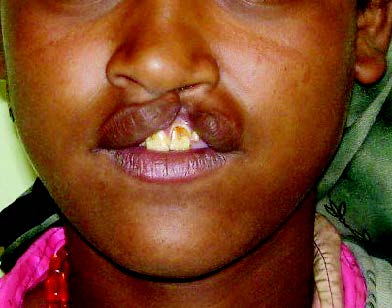
Imagine you really want to make friends with course mates at the University but you are always shunned by them due to some speech deformity, as a result of cleft lip/palate.
These friends would even go to the extent of mimicking your speech and push you off, while a lecturer would also try to tease you and look down on you because you cannot speak normally.
Undoubtedly, you would need to be a strong and courageous person to continue with life on campus in the midst of such stigmatization.
This is exactly the story of a 22- year old student who is offering sociology at the Kwame Nkrumah University of Science and Technology(KNUST).
The only girl among four boys, Ernestina Obour Tabi, has to brave the odds to stay put to ensure she becomes what she really wants to be through higher education.
She was born with cleft lip and palate and had gone through six surgeries to correct the defect to improve her nasal sounding speech through the intervention of the Ghana Cleft Foundation and the world’s largest cleft charity, Smile Train.
In her own words she tried socializing but the friends kept pushing her off.
This, she said, gave her suicidal thoughts, but her mother has been the pillar of her life as she would always have to encourage her to move on in life.
WHAT IS CLEFT LIP
OR PALATE
According to experts, a cleft lip occurs when the lip does not fuse together properly during foetal development, while a cleft palate is a hole or opening in the roof of the mouth, when the roof of the mouth (which is made up of both the hard and soft palate) does not fuse together properly
The gap is there because parts of the baby’s face did not join together properly during development in the womb.
Babies can be born with a cleft lip, a cleft palate, or both. A cleft lip may just affect one side of the lip or there may be two clefts.
It can range from a small notch to a wide gap that reaches the nose, and sometimes it can be hidden by the lining of the roof of the mouth.
Babies born with cleft lip and/or palate will often struggle with eating, breathing and speech development.
MYTHS
Despite the large number of children who are affected by cleft lip and or palate on a global scale, there are unfortunately still many myths surrounding the condition, leading to much confusion about the effect it can have, and the ways in which it can be treated.
Many people in the developing world have been regarding children born with clefts as having a disability, usually because of the associated speech or hearing difficulties and have described them as “water babies”, “babies from demigods”.Some say it is a curse on the mother for eating rabbits.
In some African societies, such children are cruelly killed, bundled in sacks and thrown into rivers. Some husbands could even divorce their wives accusing them of infidelity.
Interestingly, medical experts cannot explain the cause of cleft.
But, there is good news.It is treatable.
Typically, in developed countries, a child’s cleft will be repaired soon after birth, but in the developing world many children with clefts are not as fortunate as families often do not have access to quality healthcare services or the resources to pay for proper cleft treatment.
Prof. Peter Donkor,a surgeon with the Komfo Anokye Teaching Hospital (KATH) who doubles
as the first Vice-President, West African College of Surgeons, and the President of the Ghana Cleft Foundation, says no matter the age one has attained, the defect can be treated.
KATH, he said, treats patients with clefts through Smile Train in partnership with Ghana Cleft Foundation, which was born in 2006.The Clinic takes care of patients from across Ghana, the majority of whom are from low-resource settings, for free.
To strengthen and expand cleft lip and palate care not only in Ghana but Africa,
Smile Train, is constructing a six-storey center for surgery of children with cleft lip and or palate at a cost of has provided $2million.
The Center, being constructed at the KATH will be the first of its kind in the whole of Africa to provide corrective surgery for children with cleft lip and palate.
Ghana Cleft Foundation, through the KATH sourced the funding for the construction of the center that is expected to be completed in 18 months from September 30,2021, date of sod cutting.
Smile Train,founded in 1999 and headquartered in New York in the United States of America, is a nonprofit organization and charity providing free corrective surgery for children with cleft lips and palates, in 87 countries, training local doctors and providing hospital funding for the procedures.
The facility would consist of an out-patient department,consulting rooms, four theaters with pre-operative and post-operative wards, laboratories, stores, lecture halls,library and technical services working area.
At the ground breaking ceremony, Chief Executive of the KATH, Dr. Oheneba-Owusu Danso,noted the Ministry of Health, Ghana Cleft Foundation and Smile Train committed to a memorandum of understanding in August 2020 for the establishment of an institutional framework for a project for cleft lip and palate care in Ghana and in Africa through the establishment of the National Cleft Care Center.
The project, when completed, would boost Ghana’s position as a country “that is responsive to dynamics and modern trends in health care delivery, as well as our health tourism potential”.
“The best part of it is that the center is going to serve as a leadership center for capacity building for the cadre of health professionals on the African continent offering comprehensive cleft lip and palate care”, he stressed.
Ms. Erin Stieber, Senior Vice President of Smile Train, indicated they would continue to be committed to putting smiles on the faces of children with cleft lip and palate.
She said the establishment of the center would advance health care delivery, research and training of health professionals and that the best would be for Ghana and the entire African continent.




